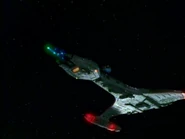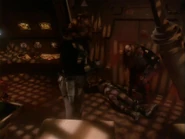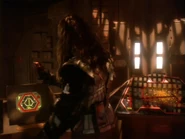m (→Studio model: quote add.) |
|||
| Line 152: | Line 152: | ||
==== Studio model ==== |
==== Studio model ==== |
||
[[File:Vor'cha studio model.jpg|thumb|The physical studio model]] |
[[File:Vor'cha studio model.jpg|thumb|The physical studio model]] |
||
| + | The ''Vor'cha''-class originated from the strong desire of the ''The Next Generation'' production staff to have a distinctive [[Klingon]] ship style of their own, as explained by [[Michael Okuda]] in 2009, "''Those two ships–the Vor’cha and the [[Negh'Var warship|Negh’Var]]–were an important part of the TNG evolution. They were the first Klingon ships in the TNG era that were not recycled from the feature films. As much as we love the battle cruiser and the bird-of-prey, we wanted very much for TNG to have a Klingon ship style of its own, and these ships gave it to us.''" [http://drexfiles.wordpress.com/2009/03/12/klingon-negh-var-transmission-point-sternbach/#comment-2888] |
||
| ⚫ | |||
| + | |||
| + | The [[studio model]] for the ''Vor'cha''-class attack cruiser was designed by [[Rick Sternbach]]. According to ''[[Star Trek: The Next Generation - The Continuing Mission]]'', Sternbach's design incorporated elements from the [[D7 class|first Klingon vessel]] designed by [[Matt Jefferies]] for ''[[TOS|The Original Series]]''. Sternbach himself noted in 2009, "''The original design style of the battle cruiser was never far from my mind, since it was such an iconic Matt Jefferies creation, and I was always determined to provide some kind of lineage, some continuity, some evolution that viewers could recognize in the new hardware. On top of that, keeping Starfleet and alien styles distinct and interesting was what many believe set Star Trek apart from other SF productions. The Vor’cHa was great challenge and an opportunity to nail some specific bits of equipment, and add a little unofficial history to the Trek scenario. Before anything else, a big tip o’ the hat to [[Greg Jein]] and his minions for the terrific miniature.(...)The attack cruiser is a bit sleeker than the previous Bird of Prey, and less of a gritty dark green. It’s still armored and armed to the teeth, however, sporting a number of disruptor banks and torpedo launchers, as well as a new main disruptor cannon.''" [http://drexfiles.wordpress.com/2009/03/12/klingon-negh-var-transmission-point-sternbach/] |
||
| + | |||
| ⚫ | Additionally, the ''[[Star Trek: The Next Generation Companion]]'' stated that the design of the ''Vor'cha''-class ship was meant to illustrate the marriage of Klingon and Federation technologies due to the ongoing détente between the two powers, as further confirmed by Sternbach, "''The structure, as well as the hull coloration, was meant to show a slight blending of Klingon and Starfleet technology, seeing as how there was something of a détente in operation''" [http://drexfiles.wordpress.com/2009/03/12/klingon-negh-var-transmission-point-sternbach/], and, "''The idea here was to combine elements of the original battle cruiser (and the hyper-detailed versions from the movies) with some slight Starfleet influence, as though there was some deliberate technology sharing between the Federation and the Klingon Empire. The color was a bit lighter and less of a saturated dark green, the wing lines a bit curvier, but overall still recognizable as Klingon.''" [http://www.ottens.co.uk/forgottentrek/tng_10.php] This translated in engines reminiscent of those of 24th century [[Starfleet]] vessels with the addition of [[Bussard collector]]s and a color scheme somewhere between the dark green of the Bird-of-Prey and the light gray of the {{USS|Enterprise|NCC-1701-D|-D}}. |
||
[[File:Gregory Jein discusses Vor'cha.jpg|thumb|left|Jein discusses the construction of the ''Vor'cha'' studio model]] |
[[File:Gregory Jein discusses Vor'cha.jpg|thumb|left|Jein discusses the construction of the ''Vor'cha'' studio model]] |
||
[[File:Rick Sternbach studies Vor'cha design.jpg|thumb|Sternbach studies his ''Vor'cha'' design]] |
[[File:Rick Sternbach studies Vor'cha design.jpg|thumb|Sternbach studies his ''Vor'cha'' design]] |
||
| − | The size Sternbach settled on was three-quarters of the length of a {{ShipClass|Galaxy}}, which was faithfully followed by |
+ | The size Sternbach settled on was three-quarters of the length of a {{ShipClass|Galaxy}}, which was faithfully followed by Greg Jein, whose company built the model, and which came in at three feet, three-quarters of the length of the new four feet model of the {{USS|Enterprise|NCC-1701-D|-D}}. Due to time restraints, Jein solicited the help of an acquaintance, [[David Merriman, Jr.]], who recalled, "''A new Klingon ship miniature would be introduced in an episode where [[Worf]] learns of the existence of a bastard son. Anyway, in Greg's cover letter that accompanied the drawings, he explained that (surprise! – ''[rem:Merriman had made several more warp engines for Jein for previous models]'' –) they needed us to make the [[warp]] engine for that miniature. And (surprise!) time was a critical issue! Though possessing a great deal more surface detail than [[Federation]] warp engines, this one was at least symmetrical i.e. the left and right sides of the unit were of identical form. So, in the interest of time, I elected to make an intermediate master of only one side, make an in-house rubber tool and cast two sets (left and right half piece). A single winglet, wart and warp engine front assembly were made as well.''" (''[[Sci-Fi & Fantasy Models]]'', Issue 30, 1998, p.39) In the bonus featurette "Select Historical Data" on disc 7 of [[TNG Season 4 DVD]] both Sternbach and Jein are interviewed about the design and construction of the ''Vor'cha''-class. |
| − | A limited run of 12, built from the same mold as the original studio model but without the internal lighting, was later sold, in 1997, at $7,000.00 apiece with a certificate of authenticity signed by Jein at the {{w|Viacom Entertainment Store}} in Chicago.{{brokenlink|url=http://web.archive.org/web/20060301030602/members.aol.com/WMccullars/vorcha.html}} The molds were later modified for the future Klingon attack cruiser seen in {{e|All Good Things...}}, a design which, in turn, developed into the |
+ | A limited run of 12, built from the same mold as the original studio model but without the internal lighting, was later sold, in 1997, at $7,000.00 apiece with a certificate of authenticity signed by Jein at the {{w|Viacom Entertainment Store}} in Chicago.{{brokenlink|url=http://web.archive.org/web/20060301030602/members.aol.com/WMccullars/vorcha.html}} The molds were later modified for the future Klingon attack cruiser seen in {{e|All Good Things...}}, a design which, in turn, developed into the ''Negh'Var'' warship. |
In "The Way of the Warrior" several other physicals models of the ''Vor'cha'' were used for the massive battle scene, supervised by [[Dan Curry]], [[Gary Hutzel]] and [[Glenn Neufeld]]. These were modified commercially available [[Playmates Toys|Playmate toys]] (No.6155) and [[AMT]] [[Star Trek model kits]] (No. 6812 ). (''[[Cinefantastique]]'', Volume 28, No.4/5, page 72) Being the first mass battle scene ever shown on ''Star Trek'', it was also the last one entirely done with physical models (save for a few shots with a CGI ''Defiant'', the only one available at the time). [[David Stipes]] repeated the procedure for {{DS9|Call to Arms}}, using the same Playmate toys as before, the last time physical models of the ''Vor'cha'' were used.[http://groups.google.nl/group/rec.arts.startrek.tech/msg/b7b8c22921513d79] |
In "The Way of the Warrior" several other physicals models of the ''Vor'cha'' were used for the massive battle scene, supervised by [[Dan Curry]], [[Gary Hutzel]] and [[Glenn Neufeld]]. These were modified commercially available [[Playmates Toys|Playmate toys]] (No.6155) and [[AMT]] [[Star Trek model kits]] (No. 6812 ). (''[[Cinefantastique]]'', Volume 28, No.4/5, page 72) Being the first mass battle scene ever shown on ''Star Trek'', it was also the last one entirely done with physical models (save for a few shots with a CGI ''Defiant'', the only one available at the time). [[David Stipes]] repeated the procedure for {{DS9|Call to Arms}}, using the same Playmate toys as before, the last time physical models of the ''Vor'cha'' were used.[http://groups.google.nl/group/rec.arts.startrek.tech/msg/b7b8c22921513d79] |
||
Revision as of 15:47, 21 December 2012
AT: "xx" The Vor'cha-class attack cruiser was one of the largest and most powerful mainstays of the Klingon Defense Forces during the mid- to late-24th century.
History
Preparing for the first Battle of Deep Space 9
The Vor'cha-class attack cruiser first appeared around 2367, when it was essentially limited to the disposal of the Klingon Chancellor and various other ranking officials. The class would eventually become fully integrated into the Klingon Imperial Fleet over the next five years.
For a time, one even served as the flagship of the Imperial Fleet, until the Negh'var warship was introduced in 2371. (TNG: "Reunion"; DS9: "The Way of the Warrior")
At least one Vor'cha-class entered the Gamma Quadrant through the Bajoran wormhole. (DS9: "Dramatis Personae")
Despite the fact the class was no longer the flagship of the Imperial Fleet, they maintained a strong presence during both the Klingon-Cardassian War and Federation-Klingon War of 2372-2373. They were used during the First Battle of Deep Space 9 and, later that year, several were used to deploy a minefield around Bajoran space. (DS9: "The Way of the Warrior", "Sons of Mogh")
The class later served as capital ships during the Dominion War, beginning in 2374. They saw action during Operation Return, the First and Second Battle of Chin'toka and the final showdown of the conflict, the Battle of Cardassia. (DS9: "What You Leave Behind")
During an alternate 26th century, at least one Vor'cha-class cruiser participated on the side of the Federation against the Sphere Builders in the Battle of Procyon V. (ENT: "Azati Prime")
In the mirror universe, the Klingon-Cardassian Alliance used the Vor'cha class in their fleet. (DS9: "Crossover")
Technical data
The Vor'cha-class was one of the more powerful ships in the Klingon Defense Forces; indeed, for a time, it was also one of the largest warships in the Empire, carrying a formidable armament and demonstrating great maneuverability considering their relatively large size. (DS9: "The Way of the Warrior", etc.)
Physical arrangement
Forward view
The outboard plan of the Vor'cha-class design incorporated the same basic shape and classic avian design lineage dating back over two hundred years.
The bridge module was separated from the main body by a thin neck that flared out into the wings, which contained the warp nacelles. A triangular superstructure was located on the dorsal section of the ship, located above the ship's impulse engines. (TNG: "Reunion", etc.)
The Vor'cha-class's secondary hull was composed of duranium alloy. (DS9: "Dramatis Personae")
Tactical systems
Heavily armed, Vor'cha's were mounted with a forward disruptor cannon capable of firing solid and intermittent disruptor beams, in addition to torpedoes. (TNG: "Redemption"; DS9: "The Way of the Warrior", "Sacrifice of Angels", "What You Leave Behind") The Vor'cha's that were utilized by the Klingon-Cardassian Alliance in the mirror universe were additionally armed with nacelle mounted disruptor cannons. (DS9: "Crossover")
The Vor'cha's were well reputed for having enough firepower to threaten a subterranean base. (DS9: "Return to Grace") Despite this reputation, the Vor'cha does have its limitations against heavily fortified targets. During the Dominion War when Chancellor Gowron chose to attack Sarpedion V, he wanted the initial strike to be lead by fifteen Vor'cha-class battle cruisers "to soften their defenses," however, according to General Martok, fifteen battle cruisers would "barely scratch their defenses." (DS9: "Tacking Into the Wind")
These vessels, like all Klingon starships of the time, also incorporated cloaking technology, which protected them from detection in most evasive situations. (TNG: "Reunion"; DS9: "Sons of Mogh")
Interior design
Main bridge
The design of the main bridge of a Vor'cha-class shared numerous similarities to other Klingon bridge designs.
Located in the front of the bridge, against the forward bulkhead, was the ship's main viewscreen. The command chair was located more forward then any of the other stations to show trust in the captain's crew, and had the ability to swivel 360 degrees, allowing the captain to visually monitor all bridge operations. At the rear of the bridge were several aft stations, including the tactical position. (TNG: "Redemption")
Ready room
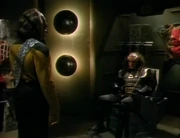
Ready room
The ready room aboard a Vor'cha was designed to emphasize the prestige and prowess of the ship's captain. Along the walls, the captain displayed weapons and trophies. (TNG: "Redemption")
Armory
The armory was located in the upper half of the ship. (DS9: "Dramatis Personae")
Engineering
The main engineering section of the ship, which contained the reactor core, was located on Deck 26. (DS9: "Dramatis Personae")
Computer access room
The computer access room was a small, unmanned room, had computer consoles and equipment placed in a semi-circle, located in the center of the room, as well as several located along the perimeter bulkheads. The computer room allowed unobstructed access to the defense system database, as well as the computer core diagnostic and navigational control systems. Access to the computer room required DNA-based hand print verification. (DS9: "Sons of Mogh")
VIP quarters
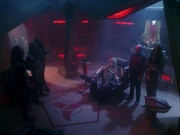
VIP quarters
The VIP quarters aboard the Vor'cha-class was a large cabin intended for visiting dignitaries.
Lush by Klingon standards, the cabin on board the attack cruiser that transported Klingon chancellor K'mpec had walls emblazoned with weapons and decorative banners of the Empire, denoting his position. There were also several movable chairs and tables located in the center of the room. (TNG: "Reunion")
Ships of the class
A painting of a Vor'cha-class ship
- Named
- Uncertain
- Unnamed
Appendices
Appearances
- TNG:
- "Reunion"
- "The Mind's Eye"
- "Redemption"
- "Redemption II"
- "Aquiel"
- "The Chase"
- "Rightful Heir"
- "Parallels" (painting)
- DS9:
- "Dramatis Personae"
- "The Way of the Warrior"
- "Sons of Mogh"
- "Apocalypse Rising"
- "By Inferno's Light"
- "Call to Arms"
- "Sons and Daughters"
- "Sacrifice of Angels"
- "You Are Cordially Invited"
- "Tears of the Prophets"
- "Image in the Sand"
- "Once More Unto the Breach"
- "Strange Bedfellows"
- "The Changing Face of Evil"
- "Tacking Into the Wind"
- "What You Leave Behind"
- VOY: "Unity"
- ENT: "Azati Prime"
Background information
The Vor'cha first appeared in TNG's "Reunion", and was first identified by name in the Star Trek Encyclopedia. The name of the class was finally made official when it was spoken in dialogue in DS9's "The Way of the Warrior", "Return to Grace", "Sons of Mogh", and "Tacking into the Wind".
According to the scripts for "Aquiel, "The Chase", "Dramatis Personae", and "Crossover", the Klingon Bird-of-Prey was intended to be used, but changed to a Vor'cha before production. This is most evident in "Crossover", where the attack cruiser was firing its disruptors from its nacelles, a location comparable to location of the turrets on a Bird-of-Prey.
Studio model

The physical studio model
The Vor'cha-class originated from the strong desire of the The Next Generation production staff to have a distinctive Klingon ship style of their own, as explained by Michael Okuda in 2009, "Those two ships–the Vor’cha and the Negh’Var–were an important part of the TNG evolution. They were the first Klingon ships in the TNG era that were not recycled from the feature films. As much as we love the battle cruiser and the bird-of-prey, we wanted very much for TNG to have a Klingon ship style of its own, and these ships gave it to us." [1]
The studio model for the Vor'cha-class attack cruiser was designed by Rick Sternbach. According to Star Trek: The Next Generation - The Continuing Mission, Sternbach's design incorporated elements from the first Klingon vessel designed by Matt Jefferies for The Original Series. Sternbach himself noted in 2009, "The original design style of the battle cruiser was never far from my mind, since it was such an iconic Matt Jefferies creation, and I was always determined to provide some kind of lineage, some continuity, some evolution that viewers could recognize in the new hardware. On top of that, keeping Starfleet and alien styles distinct and interesting was what many believe set Star Trek apart from other SF productions. The Vor’cHa was great challenge and an opportunity to nail some specific bits of equipment, and add a little unofficial history to the Trek scenario. Before anything else, a big tip o’ the hat to Greg Jein and his minions for the terrific miniature.(...)The attack cruiser is a bit sleeker than the previous Bird of Prey, and less of a gritty dark green. It’s still armored and armed to the teeth, however, sporting a number of disruptor banks and torpedo launchers, as well as a new main disruptor cannon." [2]
Additionally, the Star Trek: The Next Generation Companion stated that the design of the Vor'cha-class ship was meant to illustrate the marriage of Klingon and Federation technologies due to the ongoing détente between the two powers, as further confirmed by Sternbach, "The structure, as well as the hull coloration, was meant to show a slight blending of Klingon and Starfleet technology, seeing as how there was something of a détente in operation" [3], and, "The idea here was to combine elements of the original battle cruiser (and the hyper-detailed versions from the movies) with some slight Starfleet influence, as though there was some deliberate technology sharing between the Federation and the Klingon Empire. The color was a bit lighter and less of a saturated dark green, the wing lines a bit curvier, but overall still recognizable as Klingon." [4] This translated in engines reminiscent of those of 24th century Starfleet vessels with the addition of Bussard collectors and a color scheme somewhere between the dark green of the Bird-of-Prey and the light gray of the USS Enterprise-D.
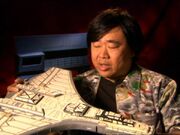
Jein discusses the construction of the Vor'cha studio model

Sternbach studies his Vor'cha design
The size Sternbach settled on was three-quarters of the length of a Template:ShipClass, which was faithfully followed by Greg Jein, whose company built the model, and which came in at three feet, three-quarters of the length of the new four feet model of the USS Enterprise-D. Due to time restraints, Jein solicited the help of an acquaintance, David Merriman, Jr., who recalled, "A new Klingon ship miniature would be introduced in an episode where Worf learns of the existence of a bastard son. Anyway, in Greg's cover letter that accompanied the drawings, he explained that (surprise! – [rem:Merriman had made several more warp engines for Jein for previous models] –) they needed us to make the warp engine for that miniature. And (surprise!) time was a critical issue! Though possessing a great deal more surface detail than Federation warp engines, this one was at least symmetrical i.e. the left and right sides of the unit were of identical form. So, in the interest of time, I elected to make an intermediate master of only one side, make an in-house rubber tool and cast two sets (left and right half piece). A single winglet, wart and warp engine front assembly were made as well." (Sci-Fi & Fantasy Models, Issue 30, 1998, p.39) In the bonus featurette "Select Historical Data" on disc 7 of TNG Season 4 DVD both Sternbach and Jein are interviewed about the design and construction of the Vor'cha-class.
A limited run of 12, built from the same mold as the original studio model but without the internal lighting, was later sold, in 1997, at $7,000.00 apiece with a certificate of authenticity signed by Jein at the Viacom Entertainment Store in Chicago.Template:Brokenlink The molds were later modified for the future Klingon attack cruiser seen in "All Good Things...", a design which, in turn, developed into the Negh'Var warship.
In "The Way of the Warrior" several other physicals models of the Vor'cha were used for the massive battle scene, supervised by Dan Curry, Gary Hutzel and Glenn Neufeld. These were modified commercially available Playmate toys (No.6155) and AMT Star Trek model kits (No. 6812 ). (Cinefantastique, Volume 28, No.4/5, page 72) Being the first mass battle scene ever shown on Star Trek, it was also the last one entirely done with physical models (save for a few shots with a CGI Defiant, the only one available at the time). David Stipes repeated the procedure for DS9: "Call to Arms", using the same Playmate toys as before, the last time physical models of the Vor'cha were used.[5]
Peirce's CGI model under duress
For appearances in later seasons of DS9, a CGI model was built at Foundation Imaging by Trevor Peirce, who gave his model the darker green color usually associated with Klingon ships, under the supervision of Ron Thornton, making its debut in DS9: "Sacrifice of Angels".
Sternbach's original sketches for this design were sold in the Profiles in History auction for US$850.00. [6] Model debris from an exploded Vor'cha-class was sold in the It's A Wrap! sale and auction for US$1,025.00. [7]
As of 2011, the studio model itself, having never been modified, save for some paint adjustments (most likely done in order to match it up with the CGI model), having escaped the 40 Years of Star Trek: The Collection and It's A Wrap! sale and auction auctions, is still in the possession of Paramount Pictures and has been on tour displays such as Star Trek World Tour, Star Trek: The Exhibition and Star Trek: The Adventure as late as 2011.[8]
Size
The size Sternbach settled on, meant that the Vorcha measured approximately 1560 feet (475,5 meter), which roughly complies with the size given in the Technical manual below. Visual Effects Supervisor David Stipes said that an overall length of 1,500 feet (457 meters) was generally used on-screen. [9]. The comparison chart drawn up by Gary Hutzel and Larry Nemecek states yet another length of 1680 feet (512 meters).[10]
Technical Manual
The following information of specifications and defenses comes exclusively from the Star Trek: Deep Space Nine Technical Manual:
- Production Base: Qo'noS Orbital Factory Base
- Type: Heavy Cruiser
- Accommodation: 1,900 plus flight crew and troops
- Power Plant: One M/A warp system; two impulse systems
- Dimensions: Length, 481.32 meters; beam, 341.76 meters; height, 106.87 meters
- Mass: 2,238,000 metric tonnes
- Performance: Warp 9.6
- Armament: Eighteen ship-mounted disruptor cannons; one large forward disruptor; three torpedo launchers
Apocrypha
- The instruction sheet of AMT/Ertl's model kit of the Vor'cha, no. 6812, based on blueprints provided by Sternbach, states that the forward part of the ship is a detachable mission specific module and interchangeable with other modules. In emergency situations it can act as a lifeboat. The model kit was designed as such.
- The Vor'cha class appears in Star Trek: Armada and Star Trek: Armada II as a cruiser. Its special weapon, the polaron torpedo, phased through a target's shields and disabled a random subsystem.
External links
- Template:NCwiki
- Vor'cha-class at Wikipedia

